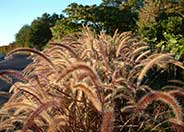
Common name:Purple Fountain Grass
Botanical name:Pennisetum 'Rubrum'
This grass will reach 6' high and has deciduous, purplish red leaves with clusters of purple flowers that appear in summer and fall. Tall grasses are highly combustible.
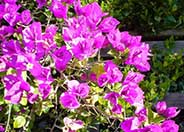
Common name:Bougainvillea selections
Botanical name:Bougainvillea cultivars
This species is hardy and vigorous, with a showy, ornamental display of purple color. It blooms well in areas with cool summers.
It is senstive to frost and will die back hard but comes back in a number of weeks. Be carefeul of this in the Santa Ynez Valley.
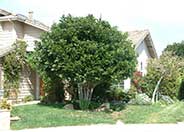
Common name:Carrotwood, Cupania
Botanical name:Cupaniopsis anacardioides
This evergreen tree will grow up to 40' high and has leathery, dark green leaves. When the trees approach maturity, yellow to orange fruit may be produced; it does well in wet soil.
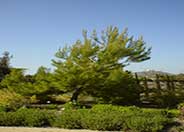
Common name:Aleppo Pine
Botanical name:Pinus halepensis
Aleppo Pine (Pinus halepensis) is a Mediterranean native tree with an upright growth habit, reaching up to 60’ tall and 40’ wide. This tree is often planted in California parks and gardens because of its drought tolerance and its natural vertical shape. This tree is too large for small gardens, but it would be appropriate in medium-to-large gardens that have the space to support it. Its natural, upright growth habit makes it very low maintenance, requiring almost no shaping or pruning when it is young. Once it has been in place for a few years, the pruning should be left to a licensed arborist to keep the tree looking and performing at its best. This tree should be planted at least 10 feet away from any hardscape areas, 30 feet from structures such as houses and buildings, and not near any powerlines. Shrubs and perennials should be planted about five feet away from this tree. It should be irrigated for about 45 minutes once a week when using most in-line drip irrigation systems. It is not recommended for fire-prone areas. Visit the Orange County Fire Authority for more information.

Common name:Sunburst Coreopsis
Botanical name:Coreopsis grandiflora
The 'Double Sunburst' is a wonderful cultivar and a showy, Southeast U.S. native. Golden yellow, double flowers on 2' bushy plants bloom during spring in full sun and average to dry soils. It makes for good cut flowers, and pruning keeps the plants abundant with blooms.
Maintenance Tips
Coreopsis grandiflora is a clumping evergreen perennial with very showy flowers that emerge in spring. This is a very drought-tolerant plant that will look and perform its best in full sun and well-drained soil. It grows 2-3’ tall and 1-2’ wide, so can be used in just about any space in any sized garden without having to prune to maintain the size. This plant rarely has any pest problems, but it is susceptible to some fungal infections, usually brought on by wet conditions in poorly drained soils. This plant will benefit from some fertilizer to keep it looking and performing its best. Deadheading is the best way to keep the plant blooming throughout the year. As soon as the flowers fade and seeding begins, the look and the health of the plant can decline. Once this happens, the plant can be cut back hard to invigorate and encourage new growth.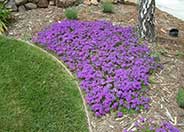
Common name:Homestead Purple Verbena
Botanical name:Verbena peruviana 'Homestead Purple'
This perennial will reach about 3' tall and has small green leaves with purple flowers that bloom all year.
Designer: N/A
Photographer: GardenSoft
Incorporate compost 6" into your soil to retain water, reduce compaction, feed earthworms, and provide valuable nutrients to your plants.
Attract, or buy beneficial insects such as ladybugs and lacewings to control pest outbreaks in your garden.